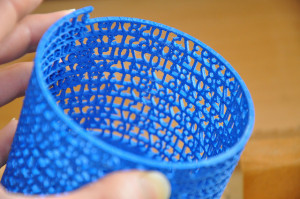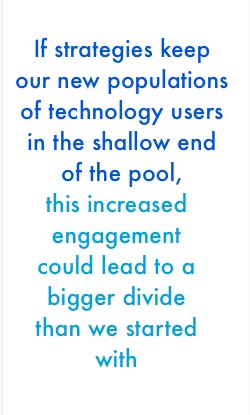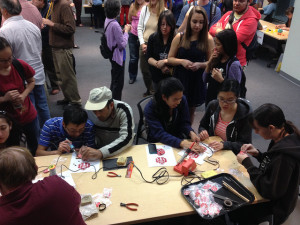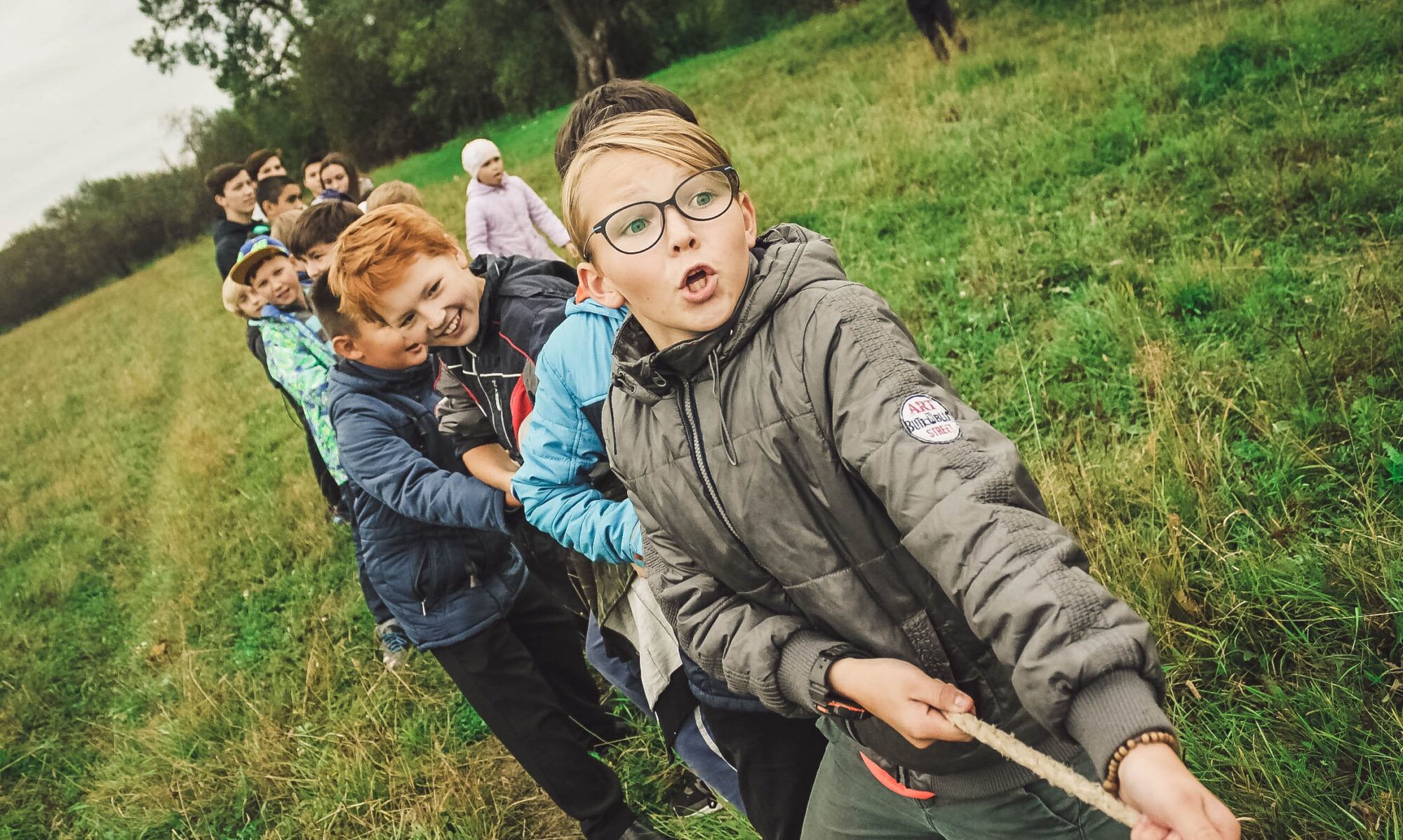How do we move all new learners to the deep end of the pool?

As I walked through an innovation showcase at SxSw 2015 (one of the the largest convergences of creative and critical thinkers last March) I was struck by the juxtaposition of two tables that were adjacent to each other.
One offered “Creative Circuit kits provide girls with all of the materials to make 10+ arts, crafts, and fashion projects with technology” the other offered “opportunities for students to replicate experiments you perform in your classrooms using an Arduino kit and a sensor kit on a nano-satellite via Nasa’s CubeSat Launch Initiatives.”
As a long time advocate for initiatives that increase the confidence and skills of girls with technology, I appreciate that the “creative circuit kit” might provide a great opportunity to engage girls with technology, but I find myself concerned that it would be easy to gain a false sense of accomplishment if we don’t move beyond ‘bling’.
I find myself wondering what are the steps that connect the excitement from “blink blink” to the curiosity that leaves you wondering “what type of sensor do I need to create an experiment that I can test in space?”
And it’s not just girls, I’m concerned about — it’s all our students (boys and girls) and our teachers. As technology becomes easier and easier to use, as developers create user interfaces using the popular design principle Don’t Make Me Think, as we advocate for a classroom where the technology is ubiquitous, the threshold for jumping in becomes lower and lower.
But are we staying in the shallow end of the pool?
I’ve watched iPads and Chromebooks fill our classrooms at a pace that surpasses previous technology adoption. I’ve watched teachers reluctant to use technology become advocates for more technology in the classroom, and hear comments like “The technology has finally become easy enough to use that even I can use it”. Even the marketing departments have caught on and speak to how easy these are to use and manage.
 The promise of easy use was not what I was hoping would lure our reluctant users to engage with technology. The promise of what’s possible when you leverage the potential of technology to solve complex problems in ways that have not previously been considered is the goal I hope we are shooting for.
The promise of easy use was not what I was hoping would lure our reluctant users to engage with technology. The promise of what’s possible when you leverage the potential of technology to solve complex problems in ways that have not previously been considered is the goal I hope we are shooting for.
Yes, I understand that the ease of use of the iPad/Chromebook or the blingy blinking LED ornament do provide a degree of accessibility for a population that might not otherwise have used the technology. And yes, engaging new populations can be one of the ways we bridge some of the equity gaps. However, if the new strategies keep our new populations of technology users in the shallow end of the pool, the increased engagement could lead to a bigger divide than we started with.
We could end up with a much more diverse group of people having moved from the sidelines to the shallow end of the pool, without impacting whose swimming in the deep end.
The recent DIY maker movement has potential to bring back the need to think more deeply, critically, and creatively with new technology tools (like Arduinos, Raspberry Pis, sensors, 3D printers, laser cutters, and more).
The exciting things about these tools is that their accessibility has the potential to empower anyone to design amazing solutions previously inconceivable. The low cost, the open ended open source power they provide, and the maker community that is engaging with these tools and with each others, is bringing back the the promise of what’s possible when you leverage the potential of technology to solve complex problems in ways that have not previously been considered.
- I’m so excited about the maker movement
- I’m feeling energized with the possibilities.
- It feels like the earlier days of technology where anything was possible with the potential of these new tools.
- It was not only about what could these tools do today.. but what will they be able to do tomorrow.. and where will this lead?
It was about innovation
Yes we must create experiences with an entrance into making accessible to a diverse population (of interest, gender, age, ability), but we must also create a pathway to move out our emerging makers out into the deep end of the maker process.
I’m talking about opportunities like the one recently provided to Vermont students from Essex to launch a balloon into space with a payload containing a GoPro, two Canon cameras, a spot GPS, an Arduino, and student fabricated parts using the school’s 3D printer and laser cutter. The students from the Computer Animation and Web Design (CAWD) program at Essex used their design skills and coding skills to successfully record the ascent and descent of the flight, detach the payload from the balloon, launch a parachute to guide the payload’s descent, and successfully retrieve it, with the sweet prize — some amazing photos and videos from Essex High School to space and back.
High Altitude Balloon Flight April 15th 2015 from cawdvt on Vimeo.
The students used their design skills, and the school’s 3D printer and laser cutter to create a design that secured the contents of their payload to space and back. They used their coding skills to program an Arduino that would collect data from a balloon as it ascended into space and terminate the flight by triggering a reaction that would heat up a nicron wire to cut through the nylon rope that attached the payload to the balloon.
After an adventurous chase, they successfully retrieved the contents of their payload, and off loaded the most amazing pictures and videos of the successful journey to space and back to Vermont.
Now that is what I call swimming in the deep end.
What does it take for students to design complex solutions like this?
It takes moving beyond bling.

Making keychains with your 3D printer and blinging out crafts is an important step in the journey. It gets a diverse group of students excited, engaged, and imagining what’s possible. It provides opportunities to build foundational skills and to bridge the experience gaps that some populations have with using the tools of the trade.
But let’s not stop there.
Let’s create opportunities for our students to gain the skills to solve complex problems or create amazing designs at the intersection of Science, Technology, Engineering, Art, and Mathematics (STEAM). Let’s move our students from the shallow end of the pool to the deep end by moving them from emerging makers, to makers that solve complex problems and create amazing designs.


Beyond Bling: how do we deepen Makerspace learning? by @techsavvygirl… http://t.co/ZpRp3S7WVv http://t.co/1hOTxZ6ASv
Beyond Bling: how do we deepen Makerspace learning? http://t.co/gKnqoYEs0b
RT @pennybishop: Beyond Bling: how do we deepen Makerspace learning? http://t.co/gKnqoYEs0b
RT @pennybishop: Beyond Bling: how do we deepen Makerspace learning? http://t.co/gKnqoYEs0b
I like this article, especially the final paragraph. Now that we are starting to establish maker spaces and these types of projects in schools and curriculums, it provides the opportunity to move forward. For me, it really brings out the constructionist framing of a constructivist model of learning. Not only are students building their own learning, they are building something physical to build, develop, and demonstrate their learning. We think about portfolios as being collections of papers or digital resources – these students’ portfolios also contain these physical artifacts. Every item has a story, and shows development and progression.
Beyond Bling: how do we deepen Makerspace learning, now that schools start to make space for makers http://t.co/f8CJ3ZMDls via @innovativeEd
Such important work, Lucie. As an educator, I can’t thank you enough for being an evangelist and gladiator for girls in STEAM. Just had one of my advisees say, “I’m going to transfer out of STEM next year.’ We had a long conversation about what she would be doing in that class and how important it was. When she found out that it was about creativity and design, she changed her mind.
For the p.m. crowd: @techsavvygirl looks at what it means to encourage deeper learning in a Makerspace http://t.co/ZpRp3RQm3X #vted
RT @pennybishop: Beyond Bling: how do we deepen Makerspace learning? http://t.co/gKnqoYEs0b
Beyond Bling: how do we deepen Makerspace learning? http://t.co/5AnIUM7b03 via @
Beyond Bling: how do we deepen Makerspace learning? http://t.co/8OvKiTtuLg via @
Beyond Bling: how do we deepen #makerspace learning? http://t.co/f2MoM8tTyg via @innovativeEd